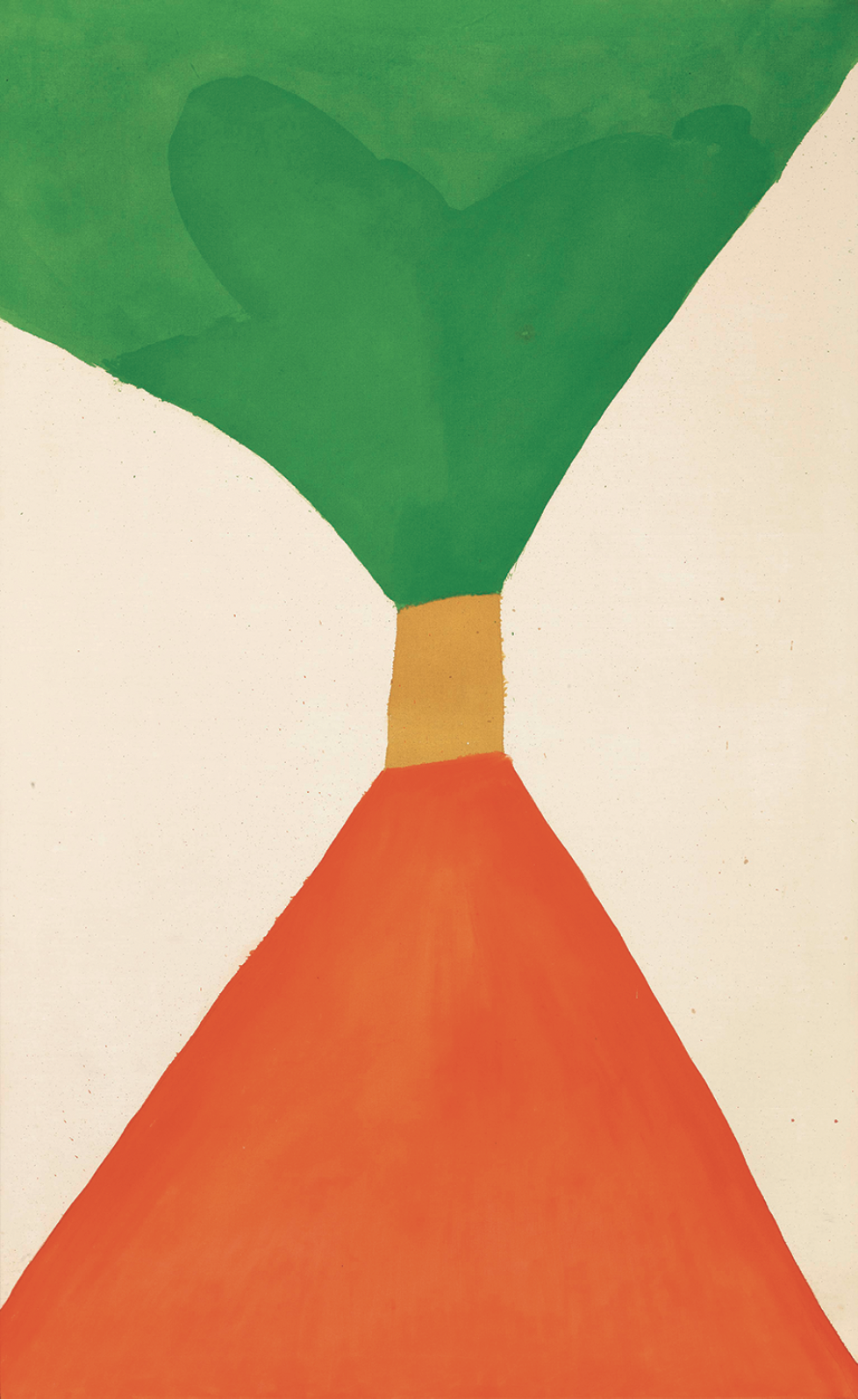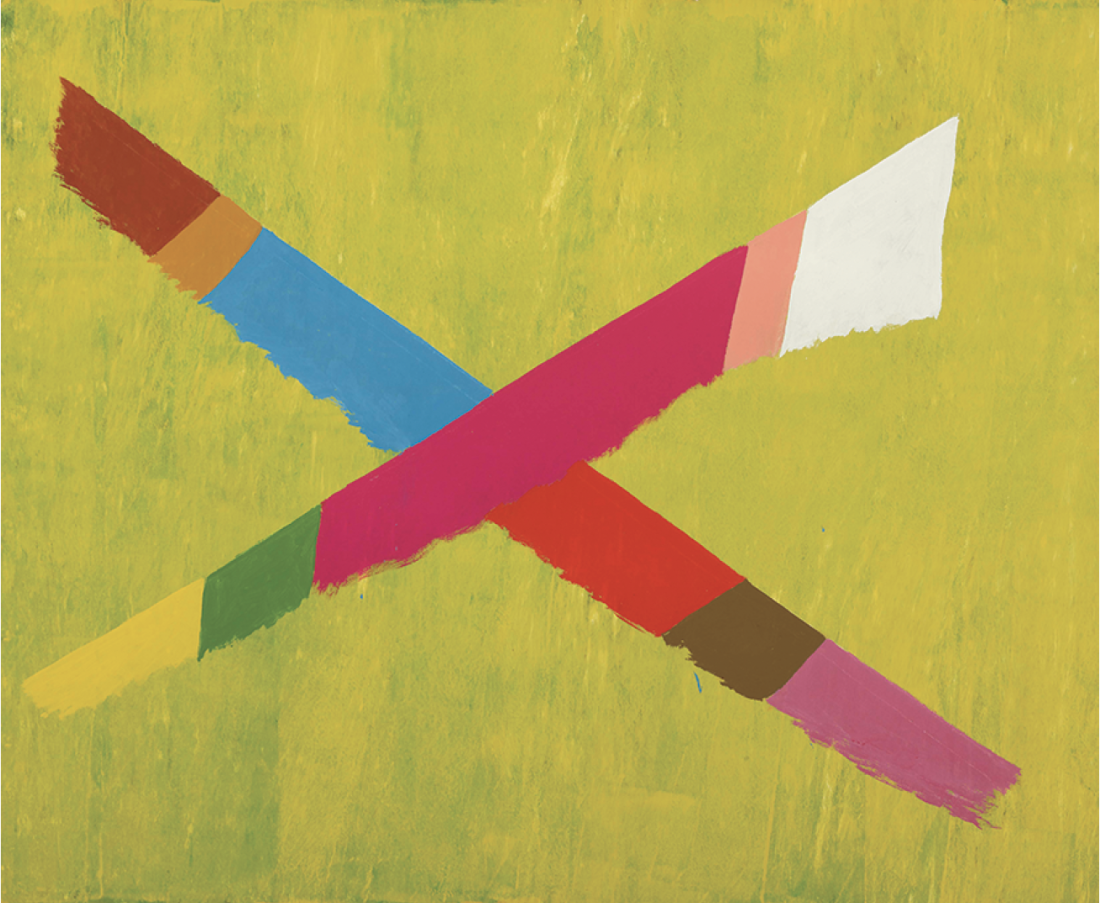Jack Bush
The Jack Bush retrospective at the National Gallery of Canada is a sweeping synopsis of the work and life of the artist as evidence of a multifaceted being. Summations of an artist’s life’s work can have the feel of a tidy story with which we’ve all become familiar. Focus is placed upon accomplishments, end results, styles forged, reputations cemented, progress lauded for its linear progression from good to better. This exhibition, however, does justice to the often unusual, unpredictable, non-linear movement of the artist through a lifetime of artistic creation. To create is to welcome uncertainty, to court failure and resist pat answers and quick solutions. It’s clear from the trajectory of this exhibition Jack Bush was in it for the long game.
Like many artists of his generation, Bush worked as an illustrator for various established companies, reserving evenings and weekends for his studio practice. This was to continue for over 40 years. Reluctant to relinquish its security, he held his position as illustrator well past his debut exhibition in Toronto, early in his artistic career. It was a career that built momentum methodically, slowly, over various forays into gestural abstraction. While the Cedar Tavern fixtures Willem de Kooning, Adolf Gottlieb, Franz Kline and Robert Motherwell were mapping out the first groundwork of an American visual identity, their infectious, standout style did cast its long shadow over the border. As with many of his Canadian contemporaries (artists such as Harold Town, Alexandra Luke, Oscar Cahén and others of the Painters Eleven, and some further afield, such as Montreal’s Charles Gagnon) American action painting took hold for Bush as well. Examples from this early period reveal all his New York influences. Jack Bush the colourist is scarcely evident in these early attempts, as viscous blacks, muted earth and ash tones predominate the work of the mid-’50s. Paint was laid on in weighty swathes, switchbacks and do-overs, gesticulations that lay bare an artist in urgent search of himself.

Jack Bush, Tight Sash, 1963, oil on canvas, 42.75 x 69.5 inches. Collection of Elizabeth A and Richard J Currie. © Jack Bush/SODRAC (2014). Photographs: Michael Cullen, TPG Digital Art Services. All images courtesy National Gallery of Canada, Ottawa.
Out of this muddled period, however, comes a startling shift of intention: a suite of five works made all the more startling for having been kept in the private collection created by his wife for the last 70 years. Housed in a separate chamber off the main galleries (and cleverly fitted out with the stark ’60s lighting, out-of-the-can white walls and requisite carpeting) hang his floral series painted in late spring of 1960. A vibrancy embedded in a lightness of touch begins to show through the paint bleeds of blossoms, leaves and atmospheric stains into canvas. The canvases are painted in saturated, thin washes in a gestural manner wisely influenced by late Matisse. It is here he finds a paint viscosity that is his friend—a loose paint that responds to canvas by absorbing much of the gesture while not subduing its directionality outright. Paint sits on the surface as much as it is embedded into it. Though one could say this is a prominent signature of the Colour Field painters, the resulting surface patina is all his own.
The 1957 visit of Clement Greenberg to Toronto had a significant influence on Jack Bush, beginning a friendship that was to carry on through numerous correspondences into the ’60s. Bush records in his diary Greenberg’s admonishment that he forgo the “New York hot licks.” Go for a “thinner, simpler” treatment, he tells him, one that places emphasis upon the optics of picture making over the surface “incident.” Regardless of the sometime fraught nature of this critic-artist relationship, the advice and encouragement fuelled Jack Bush toward his ambition to realize himself as a ‘major-league’ painter on the international scene.
A self-admitted late bloomer, Bush set out to be a practitioner of Colour Field painting alongside a generation of painters at least a decade younger than him. Undeterred, he proceeded to become one of its chief proponents. He found solid footing into the early ’60s with the “Thrusts,” a suite of works that reached back to European influences. Complex divisions of pictorial surface are punctuated by starburst formations in the centre, as in the bifurcated Red on Pink, 1962. Later came a foray into flag motifs, many on paper, which propose a more literal subject through abstracted bands of bolder, primary colour. It is in the “Sash” paintings where Bush begins to take full advantage of the drama of one colour area touching another to create an optical vibration. Close-value hues like terra rosa and crimson, burnt umber and russet magenta brace against jutting contrasts of marigold yellow and tube-bright phthalo green in Pinched Orange, 1964. Bush was unconcerned by slight bleeds of one colour into another, a natural attitude towards paint movement which gives the works a relaxed, unencumbered feel. Exactitude is avoided, and in its place there is exuberance for the simultaneity of shape, surface and colour. He was continually working out combinations and composition ideas in endless studies on small scraps of paper throughout his career, a mass of drawings smartly displayed in the centre of the exhibition. Almost as much as the paintings themselves, these sketches reveal his fresh inventive flare; the preliminary tests key to understanding the confident, straightforward execution of the larger canvas works.

Jack Bush, Ex on Spring Green, 1974, acrylic on canvas, 63.25 x 77 inches. Collection of H Arnold and Blema Steinberg. © Jack Bush/SODRAC (2014).
In 1966 Bush switched to acrylic paint, a modern polymer that allowed for faster drying time and greater access to punchy, synthetic colour. With the new medium came a tendency to move away from the relaxed, free-handed lines and towards razor-sharp, taped edges. By 1968 however, we see a return to the broad dominating shapes of solid colour punctuated by softened organic rectangles that were to become his mainstay.
The last major shift in Bush’s work came after 1969, where the even, side-by-side shape placement gives way to a subject-ground dynamic where arced bands hover on a granite-like, ragged-edged surface. This new effect was achieved by dripping darker paint onto a paint-loaded roller. The first example is Irish Rock #1. The last two large rooms of the gallery are devoted to these playful, celebratory paintings, epic in their panoramic scale and ambitious in their sense of ease. The curve and the straight edge jostle boisterously in the later works, a culmination of Bush’s ambition towards an effortless, musical synthesis of colour, shape and scale. Canada boasts an exemplar of late modernist abstraction with this show, an artist of our own we celebrate rightly with this considered, curated survey. ❚
Jack Bush was exhibited at the National Gallery of Canada, Ottawa, from November 13, 2014 to February 22, 2015.
Martin Golland is an artist and Associate Professor at the University of Ottawa.

